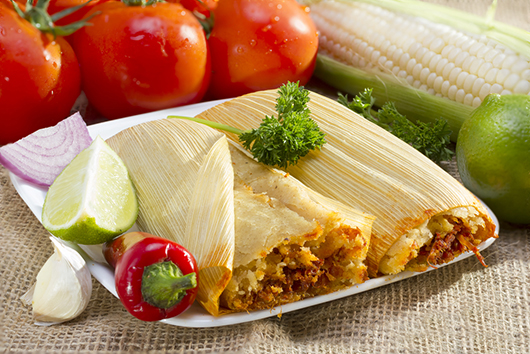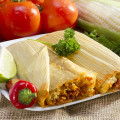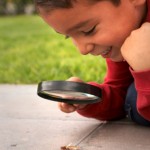
As soon as the turkey leftovers vanished last month, Rebecca Lopez’s friends began calling with a single question: “Are you going to have a tamalada this year?” Yes, ’tis the season for making and eating tamales, but it wasn’t just the food her friends yearned for; it was the sense of community and warmth they experienced at Rebecca’s past tamal-making shindigs.
A news reporter for WFAA-TV in Dallas, she had learned the ropes of cooking tamales—a process that takes the better part of a day—during the Christmas Eve tamaladas of her girlhood in Odessa, Texas. But while those were family affairs, as an adult Rebecca expanded and adapted her family’s personal Mexican food ritual to include not just her husband and son, but her closest friends, women who come from a wide cross section of races, ethnicities and cultures.
Her tamaladas became events centered on food ritual, but rooted in fellowship. They have become the key moment each year when she gives the gift of culture to her friends. “It’s a gift of love,” she says. “A gift of yourself.”
Read Related: Tamales Secrets From The Experts
LEARNING A FOOD TRADITION
“My grandmother always made tamales, so we would get together around her kitchen table,” recalls Rebecca. “She would show me how to smear the masa the right way, that’s how I learned. We used to have so much fun, we would sit around and talk and laugh and tell jokes.”
There was one constant: a small, special knife her grandmother used every single time for spreading the tamal dough on the corn husks. It was in her grandmother’s hands even after Rebecca went away to college and returned at Christmas break for the tamaladas.
After college she went to work at a Phoenix TV station and that first year she and two friends held their own tamalada. They started at six in the morning, and Rebecca was on the phone with her grandmother all day with questions. They ruined a batch of masa and had to buy some pre-made. When they finished at midnight they were exhausted. Still, when she told the story later, it ignited a fervor among others, and the following Christmas there were some 20 women who got together, donned aprons, and made tamales for themselves and as gifts.
By the time she moved to Dallas, Rebecca had her grandmother’s process down pat, from making the masa to cooking the pork, from filling the husks to steaming the tamales. In Dallas, her friends began looking forward to the annual gathering when they would take corn husks, layer masa on them, drop a dollop of pork filling on them and wrap them up for steaming.
And, says Rebecca, they also kept a tradition alive.
“To me it’s important because so many of our traditions die out within some generations,” she says. “Who wants to take time to make homemade tamales? It’s a lot of work. I wanted to carry that tradition on. I wanted to teach my friends. I wanted them to see and experience what it was like to immerse themselves in our culture.”
ANCHORED IN HERITAGE
Melissa Bourbon Ramirez, author of the Lola Cruz Mystery Series with St. Martin’s Press and Entangled Publishing, and A Magical Dressmaking Mystery series with NAL, knows what it’s like to receive this gift of culture. The blonde southern California native had been dating her husband Carlos for a while when he invited her to his family’s Christmas Eve tamalada in Sacramento.
“It was a lot of fun, it was like a party,” she says. Her future mother-in-law taught her how to spread the masa on the corn husk, as well as the other nuances of the process. “If you have corn husks that are too small, how you layer them, overlap them, leave the bottom little section free of masa so when you fold up the bottom that little area doesn’t have masa on it. It was very exacting how she wanted things done.”
“We’d spend hours, we would make hundreds of tamales,” says Melissa. “We would sit around the table and gossip, and I picked up a lot of Spanish that way.”
After they married and started a family, she and Carlos sometimes hosted their own tamaladas. Several years ago they moved to Argyle, Texas, far from his family, and the annual tradition gained significance because it anchors their five children, the oldest of whom is now in college, to their Mexican heritage, says Melissa.
“For me, it was always fun, but I also wanted the kids to have this neat recollection of this tradition that is directly related to their grandparents,” she says. “And we succeeded at that because they all like making tamales.” While not all of her kids enjoy eating tamales, “they all want to spread the masa.”
“It has turned into a sharing of the culture because they are so American,” she says. Other kids tell them that they “don’t look Mexican.” And because they don’t really speak Spanish, “this is a way to identify with that side of themselves, and that’s important to them. It’s a way to stay connected to that part of their culture.”
Melissa’s family, too, is adapting the tamalada tradition, creating vegetarian options and sharing the custom with friends who are invited each year to partake in the process.
THE GIFT OF LOVE
A divorce has left Rebecca Lopez without the space to hold tamaladas for the moment, so the last one she hosted was two years ago. She invited the women who were most influential in her life and whom she loved most dearly. They included African-Americans, Asians, Caucasians, and Latinas. As was her custom, she purchased everything, prepared the filling the day before, and when her friends arrived they prepared to assemble tamales.
But before they began she had a few words for them: “I love everyone in this room. That’s why you’re here at this time of year, when you want to share your love with friends.”
Last February her grandmother died. Prior to her death, Rebecca had videotaped her making tamales. Later this month, Rebecca will travel to Odessa for Christmas, where she will partake in the annual tamalada, this time with just her mother and her aunts. They will watch the video of their matriarch making tamales. They will prepare the usual pork and red chile filling, the masa, the corn husks. And when it comes time to fill the husks, Rebecca will use a small knife, the only one her grandmother ever used to spread masa, and which now belongs to her.
For recipes and video, please see Tamales: From Start to Finish












